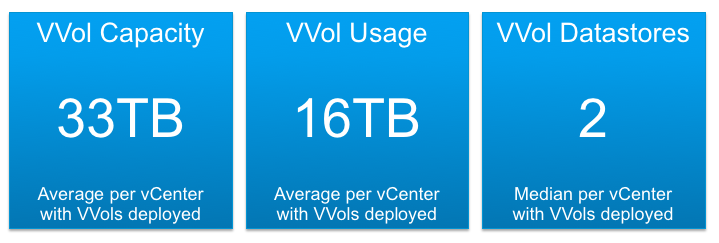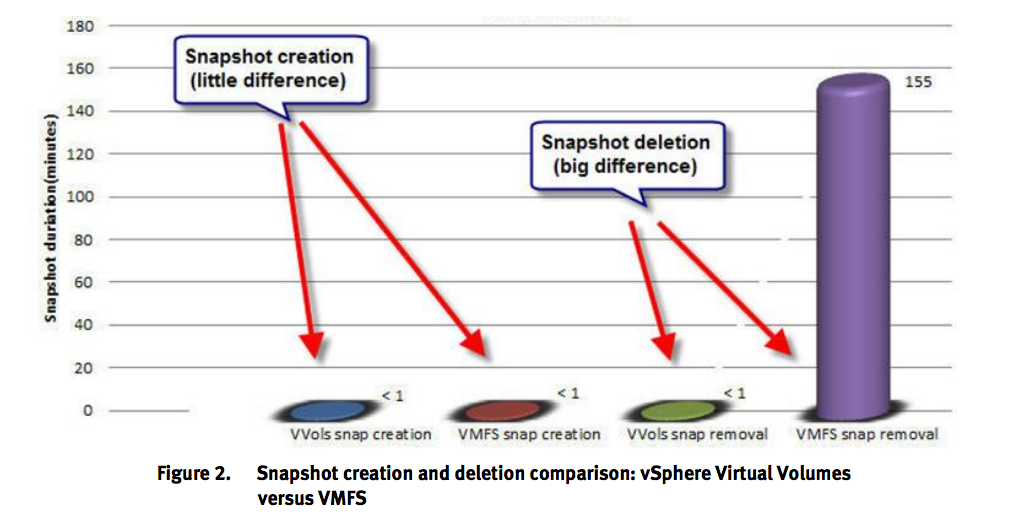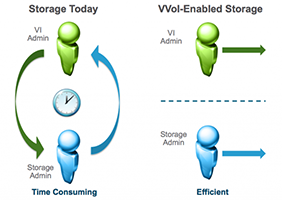With the release of vSphere 6.0, in March 2015, VMware released the long anticipated Virtual Volumes feature (a.k.a. vVols). Looking back over the past year, there has been a lot of customer interest and partner activity around Virtual Volumes. Adoption of Virtual Volumes is steadily increasing as more and more customers are moving to vSphere 6 to deliver greater agility to their businesses and to take advantage of one of the marquee features of vSphere 6.0.
How Are vVols Datastores Being Used?
The first thing we see with Virtual Volumes is that, compared to VMware Virtual Machine File System (VMFS), customers are typically provisioning relatively fewer but larger datastores. The median number of datastores deployed by a customer using vVols is two, serving on average just over 30TB of capacity with about half of that consumed by Virtual Machines.

Looking at the raw data it is difficult to determine the popular customer use cases for vVols. When chatting with customers, however, the key benefits they are seeing revolve around offloading storage operations onto the array at the virtual disk level. While different vVols implementations may be suited for different use cases, the offloading of storage operations like clones and snapshots can provide significant operational and performance benefits. It has opened up a whole new set of approaches to customers for managing application storage on vSphere, including opportunities for virtualizing physical workloads.
A great example of this are some of the performance benefits that can be seen working with business critical applications. In a white paper by the EMC VMAX team, one benchmark showed that, due to vVols and VMAX working together to offload snapshots, the time taken for snapshot deletion (and consolidation) was dramatically reduced from well over two hours to less than a minute for a highly transactional Oracle workload.

The ability to offload snapshots and clones onto the storage array opens up some additional workflows that were not easy to deliver with traditional VMFS or RDM based approaches. In the whitepaper “VMware vSphere Virtual Volumes A Game Changer for Business-Critical Oracle Databases” the benefits of vVols for Business-critical databases is explored in further detail.
Another excellent write-up on business critical applications on Virtual Volumes is Bob Goldsand’s post on “Architecting SAP HANA on Virtual Volumes with Hitachi Storage“. In this post, Bob covers the benefits of aligning storage to the demands of the application with vVols. vVols removes the leaky abstraction layer of the VMFS formatted LUN and delivers a virtual machine’s disks as native objects on the array. This simplification greatly improves collaboration between the application owners and the infrastructure teams. As a native object on the array, customers are able to make the most of their storage investments and fully integrate with VMware policy driven storage control plane for greater operational flexibility and agility.
What Does The Partner Ecosystem Look Like?
Switching gears, and looking at the vVols ecosystem, we can see that partner uptake of Virtual Volumes has been particularly strong in the first year of vVols. VMware have worked closely with its storage partners to deliver this feature and the results of this collaboration can be seen in the rapidly growing ecosystem of certified Virtual Volume implementations. At the time of this writing, we have 14 vendors with certified vVols implementations and many more planned for release in the run up to VMworld later this year.

In addition to the strong partner uptake of Virtual Volumes, we’ve also seen established vVols partners continuing to mature their implementations and implementing new capabilities. A few of examples of this can be seen by the HPE 3PAR OS 3.2.2 release delivering increased vVol scale, NetApp’s Clustered Data OnTAP VASA Provider 6.2’s new VP DR capabilities, and IBM’s snapshot handling enhancements.
Another change we have seen over the course of the year is the increasing support for Virtual Volumes on all flash storage models from our partner ecosystem. As the economics of flash become increasingly attractive, there is a broad market push towards all flash options across a range of infrastructure models including traditional, converged, and hyper-converged. We have certainly seen this customer demand for all flash Virtual SAN and our partners are also seeing the demand for their solutions. The simple policy driven approach of VMware’s Storage Policy-Based Management (integral to Virtual Volumes and Virtual SAN) integrates well with the all flash configurations entering the market. Some notable all flash arrays supporting Virtual Volumes including the latest EMC VMAX All Flash storage, Hitachi Data Systems VSP F series, Fujitsu Eternus DX 200 F, and many others.
For partners, Virtual Volumes provides the best option for deep integration with vSphere. Virtual Volumes and Storage Policy-Based Management delivers the best of both worlds to customers. Customers get the ability to leverage differentiated capabilities from their preferred storage vendor and can combine that with vSphere’s fine grained policy driven storage management.
Some Useful vVols Resources
With the increasingly broad vendor support for Virtual Volumes, now is a great time to look at vVols! If you want to learn more, Virtual Blocks has lots of great Virtual Volumes articles (including vendor demos) and other resources.
For some hands-on time with vVols check out the following Hands-On Labs:




